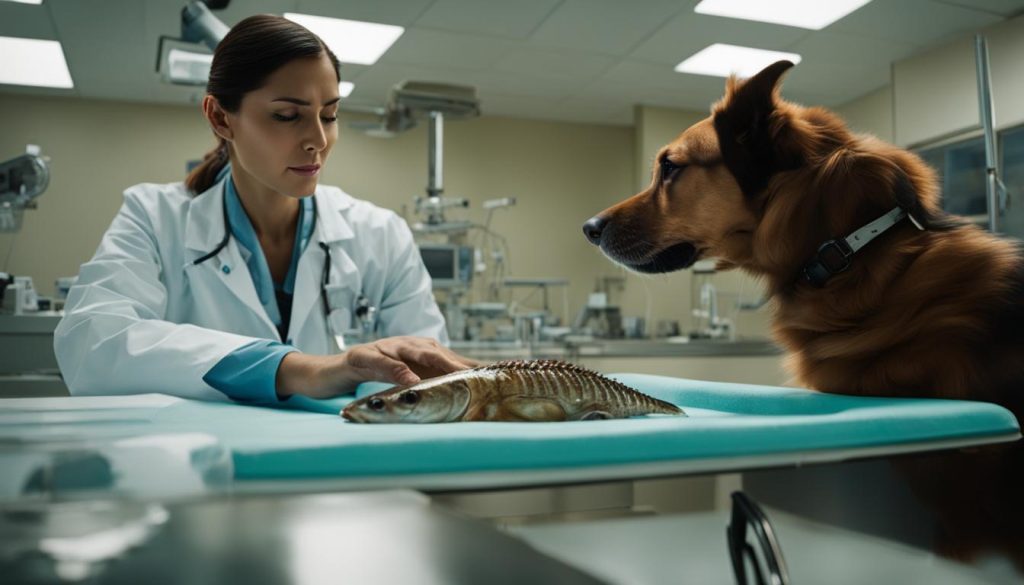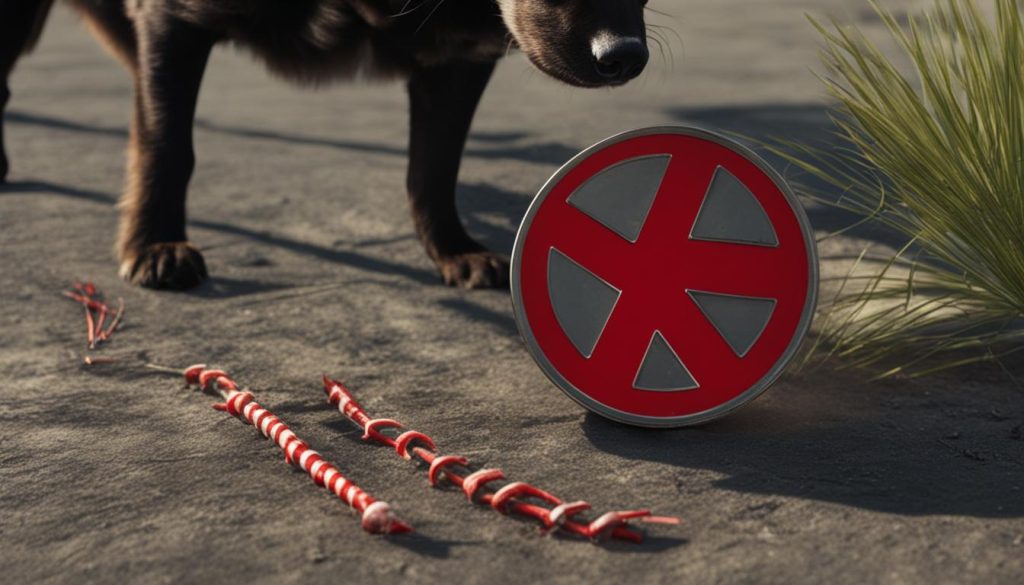The topic of whether dogs can eat fish is a common concern among pet owners. Fish is a popular food for humans, but is it safe and beneficial for our canine companions? In this article, we will explore the truth behind dogs and fish consumption to provide you with the answers you need.
Key Takeaways:
- Feeding fish to dogs can be safe and beneficial when done properly.
- There are potential risks and health concerns associated with dogs consuming fish bones.
- Consulting with a veterinarian is crucial for proper guidance on feeding fish to dogs.
- Choosing the right types of fish and removing bones is essential.
- Fish can provide lean protein and omega-3 fatty acids, promoting healthy skin, coat, and cardiovascular health in dogs.
Understanding the Risks of Dogs Eating Fish Bones

When it comes to dogs consuming fish bones, there are several risks and potential harmful effects that pet owners should be aware of. Fish bones can splinter easily and pose a choking hazard, leading to injury in the dog’s digestive tract. This can cause severe discomfort and even require veterinary intervention. It’s crucial for dog owners to understand the possible health concerns associated with feeding their dogs fish bones and take appropriate precautions to ensure their pet’s safety.
In addition to the risk of choking, fish bones can also cause internal injuries to a dog’s throat, esophagus, stomach, and intestines. The sharp edges of the bones can tear or puncture these organs, leading to severe pain, infection, and potentially life-threatening conditions. Some dogs may exhibit symptoms such as difficulty swallowing, excessive drooling, vomiting, abdominal pain, or diarrhea if they have ingested fish bones. It’s essential to monitor your dog closely and seek immediate veterinary attention if any of these symptoms occur.
To protect your dog from the harmful effects of fish bones, it is best to avoid feeding them fish with bones altogether. Instead, opt for boneless fish options or consider alternative sources of lean protein and omega-3 fatty acids that are safer for your dog’s consumption. Your veterinarian can provide guidance on suitable dietary choices and recommend appropriate supplements if needed. By being cautious and informed about the risks, you can help ensure your dog’s well-being and prevent any potential health complications.
The Safe Food for Dogs: Can They Eat Fish?

When it comes to the question of whether dogs can eat fish, the answer is a resounding yes!
Fish can actually be a safe and healthy addition to a dog’s diet. It is a great source of lean protein and omega-3 fatty acids, which support healthy skin, coat, and cardiovascular health while reducing inflammation.
Feeding fish to dogs in moderation can provide several benefits:
- Lean Protein: Fish is an excellent source of lean protein, which is essential for muscle growth and repair.
- Omega-3 Fatty Acids: Fish is rich in omega-3 fatty acids, known for their anti-inflammatory properties and positive effects on brain health. These fatty acids can also improve skin and coat health.
- Heart Health: The omega-3 fatty acids found in fish can support cardiovascular health by reducing the risk of heart disease and promoting healthy blood pressure levels.
- Joint Health: The anti-inflammatory properties of omega-3 fatty acids can help alleviate joint pain and stiffness in dogs with arthritis.
However, it’s important to feed fish to dogs in moderation and choose the right types of fish. Some fish, such as tuna and swordfish, may contain high levels of mercury, which can be harmful to dogs. It’s best to opt for low-mercury fish varieties like salmon, trout, sardines, herring, flounder, pollock, cod, tilapia, and catfish.
| Fish Type | Mercury Level |
|---|---|
| Salmon | Low |
| Trout | Low |
| Sardines | Low |
| Herring | Low |
| Flounder | Low |
| Pollock | Low |
| Cod | Low |
| Tilapia | Low |
| Catfish | Low |
In addition, it’s crucial to ensure that fish bones are removed before feeding fish to dogs. Fish bones can pose a choking hazard or cause injury to their digestive system. Cooked fish bones should be strictly avoided as they can become brittle and more likely to splinter.
Choosing the Right Fish for Dogs
When it comes to feeding fish to dogs, it’s important to choose the right types of fish that are safe and beneficial for their health. Some fish varieties are low in mercury and pose less risk to dogs, making them a better choice for inclusion in their diet. Here are some examples of low-mercury fish that are generally considered safe for dogs:
| Fish | Mercury Level |
|---|---|
| Salmon | Low |
| Trout | Low |
| Sardines | Low |
| Herring | Low |
| Flounder | Low |
| Pollock | Low |
| Cod | Low |
| Tilapia | Low |
| Catfish | Low |
These fish options provide dogs with the benefits of lean protein and omega-3 fatty acids while minimizing the potential risks associated with higher mercury levels. Please be aware that larger predatory fish like tuna and swordfish tend to have higher mercury content and should be avoided or fed in moderation to reduce the risk of mercury toxicity in dogs.
When introducing fish into your dog’s diet, it’s always a good idea to consult with a veterinarian. They can provide specific guidance based on your dog’s individual needs and health conditions. They can also offer advice on portion sizes and any precautions that need to be taken when feeding fish to your furry companion.
Dangers of Cooked Fish Bones for Dogs
Feeding dogs cooked fish bones can pose significant risks to their health and safety. Cooking fish changes the structure of the bones, making them brittle and more likely to splinter. This can lead to choking hazards or cause injury to the dog’s digestive tract. It’s essential for pet owners to understand the dangers associated with feeding dogs cooked fish bones and take appropriate precautions to keep their furry friends safe.
| Risks of Feeding Dogs Cooked Fish Bones | Dangers of Cooked Fish Bones | Cooked vs. Raw Fish for Dogs |
|---|---|---|
|
|
|
It is crucial to remember that cooking fish bones makes them more hazardous to dogs. The heat makes the bones brittle and prone to splintering, leading to potential injuries. Therefore, it is recommended to avoid feeding dogs cooked fish bones altogether. Instead, opt for feeding them raw fish or properly cooked fish without bones. This will reduce the risk of harm and ensure the overall safety and well-being of your furry companion.
Common Questions About Dogs Eating Fish

As a pet owner, you may have several questions regarding whether dogs can eat fish. Let’s address some of the most common queries to provide you with clarity on this topic.
Can dogs eat raw fish?
Feeding raw fish to dogs is generally safe, but there are important considerations. Raw fish may contain bacteria or parasites that can be harmful to dogs. It’s crucial to ensure that the fish is fresh and sourced from reputable sources. Additionally, always consult with your veterinarian to determine if raw fish is suitable for your dog’s specific dietary needs and health condition.
Is fish bad for dogs?
No, fish is not inherently bad for dogs. In fact, fish can provide dogs with essential nutrients and be a valuable addition to their diet. However, it’s important to feed fish to dogs in moderation and choose fish varieties that are low in mercury. Additionally, certain fish, like those with high levels of mercury or other toxins, should be avoided. Always consult with your veterinarian for specific dietary recommendations for your dog.
Can dogs eat tuna?
Tuna can be fed to dogs in moderation. However, it’s important to be cautious when feeding tuna to dogs as it is known to have higher levels of mercury compared to other fish. High consumption of tuna can potentially lead to mercury poisoning in dogs. If you choose to feed your dog tuna, opt for low-mercury varieties and ensure it is properly cooked and bone-free.
Can dogs eat fish skin?
While dogs can eat fish skin, it’s important to consider a few factors. Fish skin can be a good source of omega-3 fatty acids, but it may also contain higher levels of fat compared to the flesh. If your dog has a sensitive stomach or is prone to digestive issues, it’s best to remove the skin before feeding fish to your dog. Additionally, always ensure that the fish skin is thoroughly cooked to eliminate any potential parasites or bacteria.
| Question | Answer |
|---|---|
| Can dogs eat raw fish? | Feeding raw fish to dogs is generally safe, but it’s important to consider the risk of bacteria and parasites. Always consult with your veterinarian for specific guidance. |
| Is fish bad for dogs? | No, fish can be a valuable addition to a dog’s diet when fed properly. It provides essential nutrients and omega-3 fatty acids. |
| Can dogs eat tuna? | Tuna can be fed to dogs in moderation, but be cautious of mercury levels. Choose low-mercury varieties and ensure it is properly cooked. |
| Can dogs eat fish skin? | Dogs can eat fish skin, but it’s important to remove it if your dog has a sensitive stomach or is prone to digestive issues. Thoroughly cook the fish skin to eliminate potential parasites or bacteria. |
It’s essential to remember that every dog is unique, and what may be suitable for one dog may not work for another. When introducing fish or any new food into your dog’s diet, it’s always best to consult with your veterinarian to ensure you are making informed decisions about your dog’s health and well-being.
Veterinary Advice for Feeding Fish to Dogs
When it comes to feeding fish to dogs, it’s important to seek veterinary advice. A veterinarian can provide valuable guidance based on your individual dog’s needs, health conditions, and dietary requirements. They can offer specific recommendations on the appropriate types of fish to feed, portion sizes, and any precautions that need to be taken.
Tips for feeding fish to dogs may include:
- Consulting with a veterinarian to determine if fish is suitable for your dog’s overall health and any specific conditions they may have.
- Choosing fish varieties that are low in mercury to reduce the risk of toxicity.
- Removing all bones from fish before feeding to prevent choking or injury to the digestive tract.
- Cooking the fish thoroughly to eliminate potential parasites or bacteria.
- Avoiding seasoning or additives that could be harmful to dogs.
Taking these precautions can help ensure that feeding fish to your dog is done safely and beneficially. Your veterinarian can provide personalized recommendations and monitor your dog’s health to ensure that fish is a suitable addition to their diet.
| Benefits of Veterinary Advice for Feeding Fish to Dogs | Precautions for Feeding Fish to Dogs |
|---|---|
| 1. Personalized recommendations based on your dog’s needs and health conditions. | 1. Remove all fish bones to prevent choking or injury. |
| 2. Guidance on appropriate fish types and portion sizes. | 2. Thoroughly cook fish to eliminate potential parasites or bacteria. |
| 3. Monitoring your dog’s health and any potential adverse reactions. | 3. Avoid seasoning or additives that could be harmful to dogs. |
Benefits of Fish for Dogs
Fish can offer several benefits for dogs, making it a valuable addition to their diet. Here are some of the key advantages:
- Source of Omega-3 Fatty Acids: Fish is rich in omega-3 fatty acids, which play a vital role in supporting a dog’s overall health. These fatty acids are beneficial for their skin and coat, helping to reduce dryness, itchiness, and inflammation. They also support cardiovascular health and can help reduce the risk of certain diseases.
- Lean Protein: Fish is an excellent source of lean protein for dogs. Protein is essential for growth, repair, and the proper functioning of their cells and tissues. It helps support muscle development, boosts energy levels, and aids in maintaining a healthy weight.
- Essential Nutrients: Fish contains essential nutrients such as vitamins D and B12, selenium, and zinc, which are important for a dog’s overall well-being. These nutrients contribute to immune function, bone health, and the proper functioning of various bodily processes.
“Fish is a great addition to a dog’s diet, providing valuable nutrients and promoting overall health.”
Please be aware that fish should be fed to dogs in moderation and as part of a balanced diet. It should not be the sole source of nutrition and should be complemented with other appropriate foods.
| Type of Fish | Omega-3 Fatty Acids (per 100g) | Protein (per 100g) |
|---|---|---|
| Salmon | 2.2g | 22g |
| Mackerel | 1.9g | 18g |
| Sardines | 2.2g | 21g |
Table: Comparison of Omega-3 Fatty Acids and Protein Content in Different Types of Fish.
Allergies and Risks of Feeding Fish to Dogs

While fish can be a beneficial addition to a dog’s diet, it’s important to be aware of potential risks and allergies. Some dogs may have allergies or sensitivities to fish, which can manifest as skin rashes, itching, digestive issues, or even respiratory problems. If you notice any adverse reactions in your dog after feeding fish, it’s best to consult with a veterinarian to determine if fish should be avoided altogether.
Fish as an exclusive diet for dogs can also pose risks. While fish is a great source of lean protein and omega-3 fatty acids, it may not provide all the essential nutrients and balanced nutrition that dogs need. Feeding only fish as the main diet can lead to nutritional deficiencies and imbalances over time. It’s important to provide a varied and well-rounded diet to ensure your dog’s overall health and well-being.
“Some dogs may have allergies or sensitivities to fish, which can manifest as skin rashes, itching, digestive issues, or even respiratory problems.”
When introducing fish into your dog’s diet, start with small portions and observe their reaction closely. Look out for any signs of allergies, digestive upset, or unusual symptoms. If your dog tolerates fish well, you can gradually increase the portion size, ensuring it remains a part of a balanced diet. Remember to always consult with a veterinarian for specific dietary recommendations tailored to your dog’s individual needs.
Table: Risks and Allergies of Feeding Fish to Dogs
| Risks | Allergies |
|---|---|
| Choking hazards from fish bones | Skin rashes and itching |
| Injury to the digestive tract | Digestive issues |
| Mercury or toxin exposure | Respiratory problems |
| Nutritional imbalances with exclusive fish diet |
Table: Risks and Allergies of Feeding Fish to Dogs
Precautions for Feeding Fish to Dogs
When it comes to feeding fish to dogs, it’s important to take certain precautions to ensure their safety and well-being. Here are some essential guidelines to follow:
Removing Fish Bones
Before serving fish to your dog, always remember to remove all bones. Fish bones can pose a choking hazard or cause injury to the digestive tract if swallowed. Take the time to carefully check the fish and eliminate any bones, ensuring that your dog’s meal is bone-free.
Cooking Fish for Dogs
Thoroughly cook the fish before offering it to your canine companion. Cooking helps eliminate potential parasites or bacteria that could be harmful to your dog’s health. Be sure to cook the fish until it reaches an internal temperature of at least 145°F (63°C) to ensure that it is safe to consume.
Avoid Seasoning or Additives
When preparing fish for your dog, it’s important to avoid using any seasoning or additives that may be toxic to dogs. Ingredients like salt, garlic, onions, and certain spices can be harmful and should not be included in your dog’s fish meal. Stick to plain, unseasoned fish to keep it safe for your furry friend.
By following these precautions, you can ensure that feeding fish to your dog is a safe and enjoyable experience. Remember to consult with your veterinarian for specific dietary advice tailored to your dog’s individual needs.
Wrapping Up
To summarize, after exploring the topic of can dogs eat fish bones, it is important to consider several factors. Fish can be a valuable source of protein and omega-3 fatty acids for dogs, offering various health benefits such as supporting healthy skin, coat, and cardiovascular health. However, it is crucial to take precautions and feed fish to dogs in moderation.
While dogs can eat fish bones, it is essential to remove all bones before feeding to prevent choking or injury to the digestive tract. Additionally, it is advisable to choose fish varieties that are low in mercury and avoid larger predatory fish. Thoroughly cooking the fish or opting for raw fish without bones is also recommended.
It is always best to consult with a veterinarian before introducing fish into a dog’s diet or making any significant changes. They can provide tailored advice based on the dog’s individual needs, health conditions, and dietary requirements. By following these guidelines and seeking veterinary guidance, pet owners can ensure their dogs safely enjoy the benefits of fish without compromising their health.
FAQ
Can dogs eat fish bones?
Dogs consuming fish bones can pose various risks and health concerns. Fish bones can splinter or cause choking, leading to injury to the digestive tract.
Is fish safe for dogs to eat?
Fish can be a safe and healthy addition to a dog’s diet. It is a great source of lean protein and omega-3 fatty acids, which support healthy skin, coat, and cardiovascular health while reducing inflammation.
What types of fish are safe for dogs to eat?
Some examples of low-mercury fish that can be safer for dogs to consume include salmon, trout, sardines, herring, flounder, pollock, cod, tilapia, and catfish.
Are cooked fish bones safe for dogs?
Cooked fish bones should be avoided when feeding dogs as they can become brittle and pose a choking hazard or cause injury to the digestive tract. It is safer to feed dogs raw fish or properly cooked fish without bones.
Can dogs eat raw fish?
Dogs can eat raw fish, but it is important to ensure that it is fresh, properly handled, and free from parasites or bacteria that could be harmful to dogs.
Is fish bad for dogs?
Fish can be a healthy addition to a dog’s diet when fed properly. However, some dogs may have allergies or sensitivities to fish, so it’s important to monitor their reaction and consult with a veterinarian if necessary.
Can dogs eat tuna?
Tuna can be fed to dogs in moderation, but it is important to choose tuna that is low in mercury and avoid feeding it as the sole source of fish in their diet.
Can dogs eat fish skin?
Dogs can eat fish skin, but it is important to remove any seasoning or additives that could be harmful to dogs. Additionally, some dogs may have sensitivities to fish skin, so it’s important to monitor their reaction.
What precautions should I take when feeding fish to my dog?
It’s important to remove all bones from fish before feeding to prevent choking or injury to the digestive tract. Thoroughly cook the fish to eliminate potential parasites or bacteria. Avoid seasoning or additives that could be harmful to dogs.
What are the benefits of fish for dogs?
Fish is a great source of omega-3 fatty acids, which support healthy skin, coat, and cardiovascular health in dogs. It also provides lean protein and essential nutrients.
Are there any risks associated with feeding fish to dogs?
Some dogs may have allergies or sensitivities to fish. Additionally, excessive consumption of fish as an exclusive diet can lead to nutritional imbalances. It’s important to feed fish in moderation and consider the individual dog’s needs and health conditions.
How should I remove fish bones when feeding fish to my dog?
When feeding fish to dogs, it’s important to remove all bones to prevent choking or injury. Thoroughly inspect the fish and use caution when removing bones, ensuring none are left behind.






